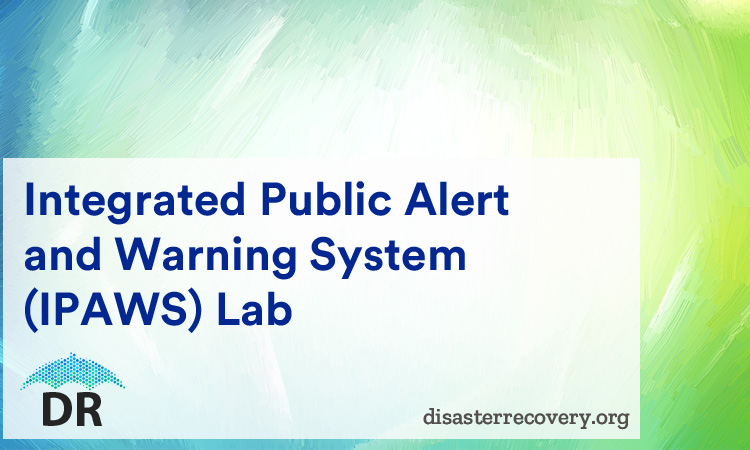Alert and warning technologies are tested on a regular basis for a variety of purposes, including:
Integrated Public Alert and Warning System (IPAWS) Lab

- Troubleshooting of issues
- Improvement of efficiency an scale of operations
- Innovation,upgrades and enhancements
- Research and Analysis
This is possible thanks to a testing facility, the IPAWS Lab, based at the Naval Surface Warfare Center in Indian Head, Maryland that the IPAWS Program Management Office (PMO) has made available to emergency officials. The lab is run under the combined jurisdictional purview of the Joint Interoperability Test Command (JITC) and the Defense Information System Agency (DISA).
The IPAWS lab allows public safety personnel to:
- Increase their familiarity with IPAWS functionalities
- Increase their expertise regarding its usage
- Effectively test the interoperability between various alert/warning technologies and IPAWS
The testing facility can support alert and warning exercises and simulations in a closed environment across all Integrated Public Alert and Warning System (IPAWS) communication channels:
- Emergency Alert System (EAS)
- Wireless Emergency Alerts (WEA)
- Non-Weather Emergency Messages (NWEM)
- IPAWS All-Harzards Information Feed
- Collaborative Operating Groups (COG)
IPAWS Lab provides:
- An interactive and closed testing environment that can also be used for purposes of training and knowledge transfer
- IPAWS Message Viewer – a standalone program for validating alerts
- Assessment of development and functional necessities
- Demo presentation
- Competent human personnel with the relevant skills and knowledge base who can support testing and troubleshooting tasks
- Space for organizing conferences, webinars, workshops, technical presentations and more
Other objectives include:
- An interactive and closed testing environment that can also be used for purposes of training and knowledge transfer
- IPAWS Message Viewer – a standalone program for validating alerts
- Assessment of development and functional necessities
- Demo presentation
- Competent human personnel with the relevant skills and knowledge base who can support testing and troubleshooting tasks
- Space for organizing conferences, webinars, workshops, technical presentations and more
Tests can be conducted through the IPAWS lab on-site, off-site or in an independent manner. Independent testing capabilities of IPAWS Message Viewer allows emergency officials to validate their alert messages through a web interface that exchanges information with the IPAWS lab environment.
Testing Initiatives
IPAWS National Test (INT)
For nearly a decade, IPAWS PMO has facilitated comprehensive testing of alerts and warnings in the public domain across the country and on various scales. In order to make frequent and in depth testing possible, IPAWS PMO created a three stage strategy for evaluation known as the IPAWS National Test (INT).
- Stage 1 – Testing in a controlled environment made available by the Joint Interoperability Test Command (JITC)
- Stage 2 – Multiple IPAWS Supported State and Regional Tests (ISSRT) with the National Periodic Test (NPT) message event code
- Stage 3 – End to End INT in real time
Stage 2 or ISSRT came into effect in 2014 when IPAWS PMO joined hands with broadcasting companies and emergency management groups within states to coordinate alert and warning system testing. This involves factoring in all the logistics involved in transmitting a pan nation emergency warning to the general public.
ISSRT Objectives:
- Evaluating the functional capabilities of IPAWS communication channels
- Archiving results to be used as a reference for future exercises
- Fostering working relationships between
- Emergency Management at the state level
- Emergency Communication chairs at the state level
- Primary Entry Point (PEP) station engineers
- Tribal Leaders, and
- Broadcast fraternity
The first ever ISSRT was conducted on September 17, 2014 at 2 pm EAST in collaboration with:
- West Virginia State
- West Virginia Division of Homeland Security and Emergency Management
- West Virginia State Emergency Communications Chair
- West Virginia Broadcasters Association
After gathering results from the testing exercises in West Virginia, IPAWS PMO facilitated a number of ISSRT drills. This was particularly useful for broadcast companies and cable operators who were trying to gauge the ability of their establishments to transmit IPAWS warnings in a simulated environment. The testing drill in November, 2015, marked a linguistic milestone for IPAWS as the agency relayed for the first time an emergency message that could be transmitted in either Spanish or English, depending on user preference. After successfully conducting nine tests in collaboration with 46 states, the District of Columbia, and the U.S. Virgin Islands, the ISSRT stage of the IPAWS INT was brought to its logical conclusion in June, 2016.
Wide scale testing drills across the nation commenced after the new FCC rules became applicable. These rules detailed:
FEMA relayed a nationwide NPT EAS message on September 28, 2016 at 2:20 pm EDT from the IPAWS Lab in Indian Head, Maryland. Besides bilingual support in English and Spanish, the test emergency alert content was available in audio as well as text. Nearly 95 percent of vendors in the broadcast, satellite and cable services sector participated in the drill and nearly 88 percent reported a successful transmission of the alert message. The FCC EAS Test Reporting System (ETRS) was used by these vendors to provide detailed reports that furnished all the details regarding how they handled the transmission of the message. The data gathered at the ETRS system provide valuable inferences for different alerting groups, including:
- How the National Periodic Test message should be handled
- Prerequisites for generating reports on exercise results
- State emergency managers
- Alerting authorities
- State Emergency Communication Committees (SECCs)
This allows the alert and warning system to be constantly upgraded in a continuous effort at improvement.

